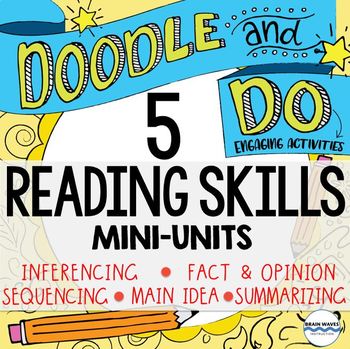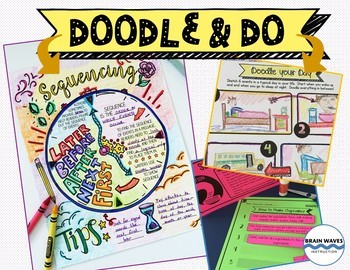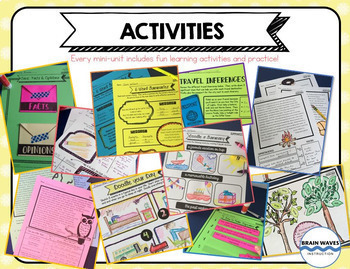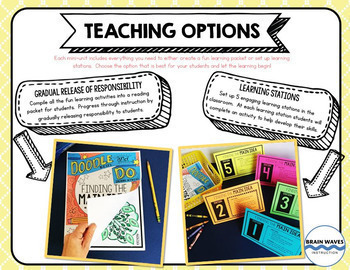Reading Comprehension Lessons with Reading Passages and Questions - Doodle Notes
- Zip
What educators are saying
Products in this Bundle (5)
Also included in
- This bundle of Doodle and Do resources includes 11 units to help your students develop their skills as readers! Each resource includes highly engaging doodle notes that pair with skills-based activities to help students showcase their learning! About the 5 Reading Skills Mini-UnitsHere’s how the reaPrice $53.99Original Price $62.89Save $8.90
Description
Finding reading comprehension lessons, passages, and questions that don't completely bore students can be a challenge. That's where these reading doodle notes, engaging reading passages, and fun reading activities come in. This set of reading mini-units focus on making inferences, finding the main idea, summarizing, sequencing and differentiating between facts and opinions.
Here's. the best part...everything about these reading mini-units is designed with engagement in mind. Get students excited about reading with these Doodle and Do mini-units! This bundle of Doodle and Do mini-units is the perfect way to address critical reading skills and get students excited about learning.
GREAT NEWS! This bundle of resources is included in the Doodle and Do Reading Bundle! The Doodle and Do Reading Bundle is comprised of 11 resources that combine doodle notes with engaging tasks to help students showcase their learning. The bundle includes 5 Reading Skills mini-units, 5 Nonfiction Text Structures mini-units, and 6 Reading Response doodle notes and responses! Check it out HERE!
Here’s how each mini-unit works: First, students complete highly engaging Doodle Notes about each reading comprehension skill. Then, they complete 5 fun learning activities and read passages to help them develop the skill. There are 3 reading comprehension passages included in each mini-unit.
Mini-Units in this bundle: Making Inferences, Finding the Main Idea, Sequencing, Summarizing, and Fact and Opinion
Each mini-unit is completely customizable, too! First, there are two types of doodle notes included (filled-in and guided notes versions) in each unit. This makes it easy to differentiate instruction. Then, there are two instructional versions included in every mini-unit! You can either put together a fun student packet with reading skills worksheets, or you can set up 5 learning stations. This way, you can create the very best learning experience for your students!
The Doodle and Do mini-units are designed to be taught over the course of 2-3 days.
About “Doodle” Notes:
First, students will learn all about each reading skill by completing a set of doodle notes. Doodle notes are color-it-in, fill-it-in, and doodle-encouraging note sheets. They’re not only visually engaging, they’re also effective in helping students increase their focus and ability to recall information. Plus…they’re really fun! In each mini-unit, there are 2 options of Doodle Notes:
- Option 1: All the notes are filled in. With this option students will color, embellish, and add doodles to the notes as you review the information with the class.
- Option 2: Some of the notes are filled in and students need to fill in the remainder of the notes (like guided notes). Students will work to fill in the notes as you teach the content.
Learn more about each mini-unit
SEQUENCING – Doodle and Do Mini-Unit
Help students learn all about sequencing with this super fun Doodle and Do mini-unit! This resource includes sequencing graphic organizers, reading comprehension worksheets and passages that help students determine the sequence of events in a text, and hands-on learning activities to help students understand sequencing.
About the activities
- Doodle Notes: Students color-in, fill-in, and doodle-on engaging notes about sequencing.
- Putting Events in Order: Students will review a mixed-up set of directions. Then, they’ll investigate signal words and phrases to put the events in the correct order. This cut-and-paste activity is hands-on and fun!
- Doodle Your Day: Students take the “doodle” theme a bit further as they doodle 6 events from their day in sequential order.
- 3 Reading Passages: Students read 3 different reading passage. Two passages are nonfiction. One passage is fiction. After reading each passage, students complete different tasks including graphic organizers and short answer questions.
The detailed Sequencing “Doodle and Do” resource includes:
- A detailed teacher overview of the resource
- Lesson Plans – Instructional Option #1 – Gradual Release of Responsibility (student packets)
- Lesson Plans – Instructional Option #2 – Learning Stations
- Doodle Notes – Sequencing (all filled-in)
- Doodle Notes – Sequencing (guided notes)
- “How to Make Cupcakes” worksheet
- “Putting Events in Order” worksheet
- Doodle Your Day Activity
- 3 Reading Passages – 2 nonfiction, 1 fiction
- 5 Learning Stations Cards (with student directions – to use if you choose to set up learning stations)
- All Instructional Keys
FINDING THE MAIN IDEA – Doodle and Do Mini-Unit
Learning how to identify the main idea in a passage is absolutely essential. That’s why this mini-unit on finding the main idea is a hit! It combines doodle notes where students sketch notes about how to find the main idea and actual learning activities to help students improve their reading comprehension skills.
About the activities
- Doodle Notes: Students color-in, fill-in, and doodle-on engaging notes about facts and opinions.
- Supporting Details Sort: Students cut and sort supporting details into main idea categories. Then, they identify the main idea before they glue the supporting details onto main idea trees.
- Doodle the Details: Students take the “doodle” theme a bit further as they doodle supporting details for 3 different main ideas.
- 3 Reading Passages: Students read 3 different reading passage. Two passages are nonfiction. One passage is fiction. After reading each passage, students complete different tasks to identify supporting details and determine the main idea.
The detailed Finding the Main Idea “Doodle and Do” resource includes:
- A detailed teacher overview of the resource
- Lesson Plans – Instructional Option #1 – Gradual Release of Responsibility (student packets)
- Lesson Plans – Instructional Option #2 – Learning Stations
- Doodle Notes – Finding the Main Idea (all filled-in)
- Doodle Notes – Finding the Main Idea (guided notes)
- Supporting Details – sort shapes
- Main Idea Trees
- Doodle the Details
- 3 Reading Passages – 2 nonfiction, 1 fiction
- Learning Stations Cards (with student directions – to use if you choose to set up learning stations)
- All Instructional Keys
Making Inferences– Doodle and Do Mini-Unit
Students often struggle with making inferences while reading. That’s because inferring is a challenging skill! Help students develop their inferring skills with this incredibly fun and engaging mini-unit. It combines doodle notes where students sketch notes about how to make inferences AND actual learning activities to help students improve their reading comprehension skills. It’s fun and educational!
About the activities:
- Doodle Notes: Students color-in, fill-in, and doodle-on engaging notes about making inferences.
- Travel Inferences: Students review travel itineraries and collect clues about the cities that are described. Then, they combine the clues with their own background knowledge to make an inference. This cut-and-paste activity is hands-on and fun!
- Doodle an Inference: Students take the “doodle” theme a bit further as they doodle the contents of gift boxes based on inferences that they make from gift tag descriptions.
- 3 Reading Passages: Students read 3 different reading passage. Two passages are nonfiction. One passage is fiction. After reading each passage, students complete different tasks to make inferences.
The detailed Making Inferences “Doodle and Do” resource includes:
- A detailed teacher overview of the resource
- Lesson Plans – Instructional Option #1 – Gradual Release of Responsibility (student packets)
- Lesson Plans – Instructional Option #2 – Learning Stations
- Doodle Notes – Making Inferences (all filled-in)
- Doodle Notes – Making Inferences (guided notes)
- Passport – Travel itinerary shapes
- Travel Inferences (2 pages)
- Doodle an Inference
- 3 Reading Passages – 2 nonfiction, 1 fiction
- Learning Stations Cards (with student directions – to use if you choose to set up learning stations)
- All Instructional Keys
FACT AND OPINION – Doodle and Do Mini-Unit
Ready to get students excited about identifying facts and opinions in texts? Then, you and your students are going to love this Doodle and Do mini-unit! With this set of fact and opinion lesson plans, students will learn how facts and opinions differ and how to identify facts vs. opinions in reading passages. It’s fun and educational! First, students DOODLE and then they DO activities to help them showcase their learning!
About the activities
- Doodle Notes: Students color-in, fill-in, and doodle-on engaging notes about facts and opinions.
- Fact and Opinion Sort: Students create fact and opinion envelopes. Then, they fill each envelope with fact and opinion cards. This cut-and-paste activity is hands-on and fun!
- Doodle Exchange: Students take the “doodle” theme a bit further as they doodle different sketches. Then, they exchange their sketches with a partner who lists facts and opinions about each doodle.
- 3 Reading Passages: Students read 3 different reading passage. After reading each passage, students complete different tasks as they identify facts and opinions.
This detailed Fact and Opinion “Doodle and Do” resource includes:
- A detailed teacher overview of the resource
- Lesson Plans – Instructional Option #1 – Gradual Release of Responsibility (student packets)
- Lesson Plans – Instructional Option #2 – Learning Stations
- Doodle Notes – Fact and Opinion (all filled-in)
- Doodle Notes – Fact and Opinion (guided notes)
- Fact and Opinion Cut and Sort Activity
- Doodle Exchange Activity
- 3 Reading Passages
- Learning Stations Cards (with student directions – to use if you choose to set up learning stations)
- All Instructional Keys
SUMMARIZING – Doodle and Do Mini-Unit
Teaching students how to summarize can be a daunting task. Often, it’s one of the hardest reading strategies for students to grasp. That’s where this Doodle and Do mini-unit comes in! This resource includes summarizing graphic organizers, reading comprehension worksheets and passages that help students practice the skill of summarizing texts.
About the activities
- Doodle Notes: Students color-in, fill-in, and doodle-on engaging notes about summarizing.
- 6-Words Summaries: Students create six-word summaries for different different nurseries rhymes.
- Doodle a Summary: Students take the “doodle” theme a bit further as they doodle a summary of different events in their lives.
- 3 Reading Passages: Students read 3 different reading passage. After reading each passage, students complete different tasks including graphic organizers and short answer questions.
The detailed Summarizing “Doodle and Do” resource includes:
- A detailed teacher overview of the resource
- Lesson Plans – Instructional Option #1 – Gradual Release of Responsibility (student packets)
- Lesson Plans – Instructional Option #2 – Learning Stations
- Doodle Notes – Summarizing (all filled-in)
- Doodle Notes – Summarizing (guided notes)
- “6-Word Summaries” worksheets (2)
- Doodle a Summary activity
- 3 Reading Passages
- 5 Learning Stations Cards (with student directions – to use if you choose to set up learning stations)
- All Instructional Keys
Other Doodle and Do Resources…
- 5 Nonfiction Text Structure Mini-Units
- How to Study for a Test Doodle Notes and 5 Learning Stations
- Writing Responses with Text-Based Evidence Doodle Notes and 5 Learning Stations
Or, you may also like…
- 12 Reading Comprehension Mini-Units
- 12 Writing Units Bundle - Writing instruction for an entire year!
- Figurative Language Unit
Following is Fun!
Get the inside scoop on all store discounts, free products, and product launches. Just click the green “Follow Me” star under my store name on this page or click the green “Follow Me” star on my store homepage.
Let’s Stay in Touch!
*** Click HERE to receive the Brain Waves Instruction Newsletter filled with exclusive FREEBIES and Teaching Tips!
Thanks!
Brain Waves Instruction
Doodle notes is a trademarked term used with permission. Please visit doodlenotes.org for more information.






